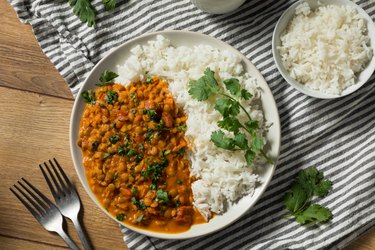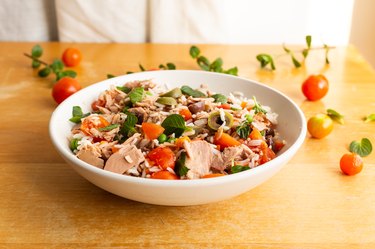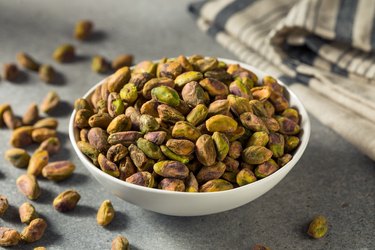
Outside of tofu, beans and nuts, the number of high-protein plant-based foods seems far and few in between compared to animal sources. Sure, there are plenty of vegan meat substitutes, but they should be eaten only occasionally.
One of the best whole-food plant protein sources are lentils. These tiny legumes are nutrition powerhouses that not only provide a wealth of vitamins and minerals but also impart a variety of flavors to your dishes. For example, brown lentils have a more mild and earthy flavor while red lentils impart sweetness and nuttiness to dishes, according to the Food and Agriculture Organization of the United Nations.
Video of the Day
Video of the Day
Here, dietitians break down all the reasons you'll want to pile your plate with lentils more often than not.
The Health Benefits of Lentils
According to the USDA, 1 cup of cooked lentils provides:
- Calories: 230
- Total fat: 0.8 g
- Saturated fat: 0.1 g
- Cholesterol: 0 mg
- Sodium: 4 mg
- Total carbs: 39.9 g
- Dietary fiber: 15.6 g
- Sugar: 3.6 g
- Added sugar: 0 g
- Protein: 17.9 g
1. Lentils Are High in Protein
Lentils are an excellent source of protein, which is essential for building muscle and curbing hunger. Protein is made up of essential and non-essential amino acids, and your body needs both types of amino acids to meet your needs. Complete proteins have all nine essential amino acids while incomplete proteins are missing one or more essential amino acids.
"Lentils are a great source of protein, especially for vegans and vegetarians. Approximately 1/2 cup of cooked lentils has 12 grams of protein. Sprouted lentils have all essential amino acids, making them a complete protein," says Sarika Shah, RD, a dietitian based in San Ramon, California. "However, cooked lentils contain essential amino acids but are limited in two: methionine and tryptophan."
That said, you can pair cooked lentils with grains, like rice and cornbread, to make it a complete protein Shah says.
The other great perk of lentils is that they don't require any soaking like other dried beans, and only take 15 to 20 minutes to cook, says Rachel Gargano, RD, a dietitian at Top Nutrition Coaching. And canned lentils make it even more convenient to reap the protein benefits.
2. They're a Great Source of Fiber
Another reason lentils get an A+ in nutrition is that they're a great source of soluble fiber, providing about 4 to 9 grams per 1/2 cup cooked, Shah says.
FYI, there are two different types of fiber: soluble and insoluble fiber. Soluble fiber primarily comes from beans and legumes, vegetables and nuts and seeds and helps slow digestion so it keeps you full and helps lower your risk of heart disease. On the other hand, insoluble fiber is mainly found in whole grains, vegetables and wheat bran and adds bulk to your stool, according to the U.S. National Library of Medicine.
"Soluble fiber has heart health benefits by aiding in lowering LDL and total cholesterol. The fiber will also help with bowel movements and help feed our good gut bacteria," she says.
3. They're High in Iron
A big plus to eating more lentils is that they provide iron. In fact, 1 cup of cooked lentils has around 36 percent of your Daily Value (DV) of iron. That's more than 20 percent DV of iron in 1 cup of cooked black beans and 29 percent DV in a cup of cooked red kidney beans.
"Eating enough foods high in iron is important for growth and regular body functions, including transporting oxygen throughout the body," says Bianca Tamburello, RD, a dietitian at FRESH Communications. More specifically, iron helps your body produce hemoglobin, which provides oxygen to your lungs and to different organs throughout your body, Shah says.
According to the National Institutes of Health (NIH), people who menstruate need higher amounts of iron because they lose iron during their periods. Pregnant people also need more iron because they produce twice the amount of blood and need iron to support their growing baby, so lentils would be a great addition to a pregnancy diet.
Tip
When eating non-heme iron food sources, such as lentils, make sure to pair them with vitamin C-rich foods to increase iron absorption, Tamburello says. "Take advantage of this savvy nutrition tip and increase your iron absorption by drizzling lemon juice on lentils or pair lentils with vitamin C-rich spinach or red bell peppers."
4. They Contain B Vitamins and Minerals
These little legumes offer a wealth of B vitamins, including thiamine (vitamin B1), niacin (vitamin B3), vitamin B6 and folate (vitamin B9), and minerals, such as magnesium, potassium and zinc, according to Shah and Tamburello.
"Folate found in lentils is important for the creation of red blood cells and the growth of healthy body cells and is particularly important for women of childbearing age to prevent birth defects," Tamburello says.
B vitamins are essential for transporting other nutrients and maintaining the health of your skin and brain cells, Shah says. They also help convert food into energy and help form red blood cells, Gargano says.
Potassium and magnesium can help lower blood pressure and help your heart, kidneys and muscle function properly.
Delicious Ways to Enjoy Lentils
Soups and stews are easy and nutritious ways to incorporate more lentils into your diet. Tamburello likes making Italian-inspired lentil soup and slow-cooker coconut curried lentils. "In the warmer months, I also enjoy preparing cold lentils as a flavorful salad topper."
Shah enjoys lentils the most in kichadi, which is a traditional Gujarati meal made of lentils, rice with turmeric, salt and ghee. "For quick meals, I like to use canned lentils for taco filling or add to a marinara sauce to make a vegan bolognese or add to a salad."
Need inspiration? Try these comforting lentil recipes.


